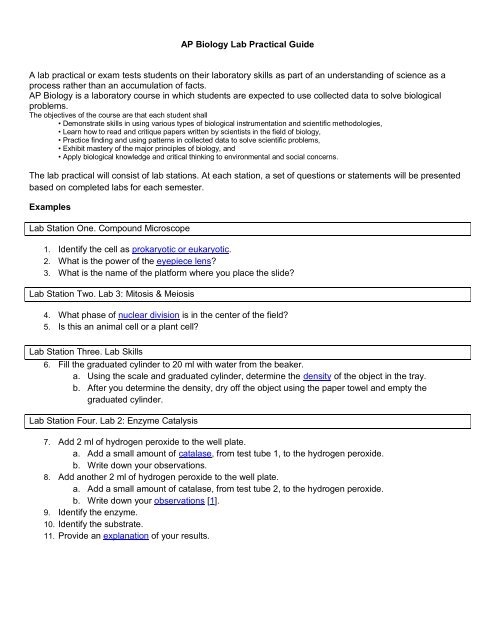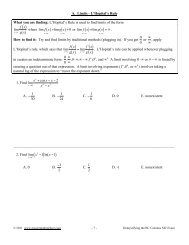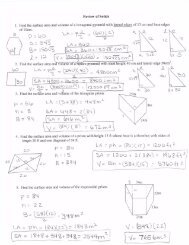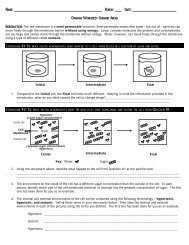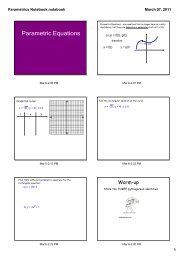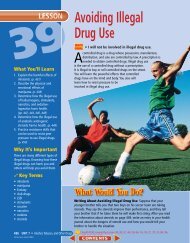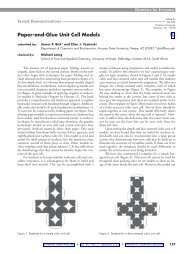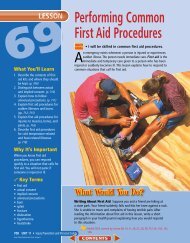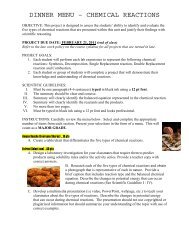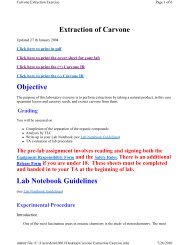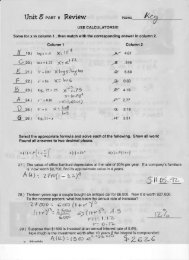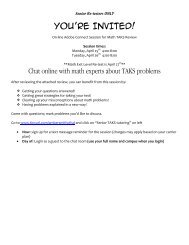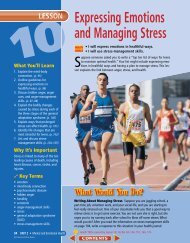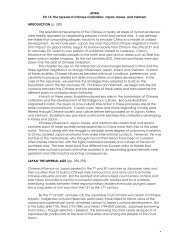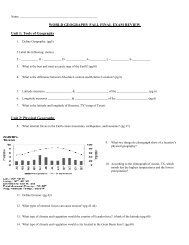AP Biology Lab Practical Guide A lab practical or exam tests ...
AP Biology Lab Practical Guide A lab practical or exam tests ...
AP Biology Lab Practical Guide A lab practical or exam tests ...
Create successful ePaper yourself
Turn your PDF publications into a flip-book with our unique Google optimized e-Paper software.
<strong>AP</strong> <strong>Biology</strong> <strong>Lab</strong> <strong>Practical</strong> <strong>Guide</strong><br />
A <strong>lab</strong> <strong>practical</strong> <strong>or</strong> <strong>exam</strong> <strong>tests</strong> students on their <strong>lab</strong><strong>or</strong>at<strong>or</strong>y skills as part of an understanding of science as a<br />
process rather than an accumulation of facts.<br />
<strong>AP</strong> <strong>Biology</strong> is a <strong>lab</strong><strong>or</strong>at<strong>or</strong>y course in which students are expected to use collected data to solve biological<br />
problems.<br />
The objectives of the course are that each student shall<br />
• Demonstrate skills in using various types of biological instrumentation and scientific methodologies,<br />
• Learn how to read and critique papers written by scientists in the field of biology,<br />
• Practice finding and using patterns in collected data to solve scientific problems,<br />
• Exhibit mastery of the maj<strong>or</strong> principles of biology, and<br />
• Apply biological knowledge and critical thinking to environmental and social concerns.<br />
The <strong>lab</strong> <strong>practical</strong> will consist of <strong>lab</strong> stations. At each station, a set of questions <strong>or</strong> statements will be presented<br />
based on completed <strong>lab</strong>s f<strong>or</strong> each semester.<br />
Examples<br />
<strong>Lab</strong> Station One. Compound Microscope<br />
1. Identify the cell as prokaryotic <strong>or</strong> eukaryotic.<br />
2. What is the power of the eyepiece lens?<br />
3. What is the name of the platf<strong>or</strong>m where you place the slide?<br />
<strong>Lab</strong> Station Two. <strong>Lab</strong> 3: Mitosis & Meiosis<br />
4. What phase of nuclear division is in the center of the field?<br />
5. Is this an animal cell <strong>or</strong> a plant cell?<br />
<strong>Lab</strong> Station Three. <strong>Lab</strong> Skills<br />
6. Fill the graduated cylinder to 20 ml with water from the beaker.<br />
a. Using the scale and graduated cylinder, determine the density of the object in the tray.<br />
b. After you determine the density, dry off the object using the paper towel and empty the<br />
graduated cylinder.<br />
<strong>Lab</strong> Station Four. <strong>Lab</strong> 2: Enzyme Catalysis<br />
7. Add 2 ml of hydrogen peroxide to the well plate.<br />
a. Add a small amount of catalase, from test tube 1, to the hydrogen peroxide.<br />
b. Write down your observations.<br />
8. Add another 2 ml of hydrogen peroxide to the well plate.<br />
a. Add a small amount of catalase, from test tube 2, to the hydrogen peroxide.<br />
b. Write down your observations [1].<br />
9. Identify the enzyme.<br />
10. Identify the substrate.<br />
11. Provide an explanation of your results.
The following <strong>lab</strong><strong>or</strong>at<strong>or</strong>y objectives will be tested f<strong>or</strong> <strong>Lab</strong> <strong>Practical</strong> One:<br />
LABORATORY 1: Diffusion and Osmosis<br />
OBJECTIVES<br />
Section A: Bef<strong>or</strong>e doing this <strong>lab</strong><strong>or</strong>at<strong>or</strong>y you should understand:<br />
the mechanisms of diffusion and osmosis and their imp<strong>or</strong>tance to cells<br />
the effects of solute size and concentration gradients on diffusion across selectively permeable membranes<br />
the effects of a selectively permeable membrane on diffusion and osmosis between two solutions separated by<br />
the membrane<br />
the concept of water potential<br />
the relationship between solute concentration and pressure and the water potential of a solution<br />
the concept of molarity and its relationship to osmotic concentration<br />
Section B: After doing this <strong>lab</strong><strong>or</strong>at<strong>or</strong>y you should be able to:<br />
measure the water potential of a solution in a controlled experiment<br />
determine the osmotic concentration of living tissue <strong>or</strong> an unknown solution from experimental data<br />
describe the effects of water gain <strong>or</strong> loss in animal and plant cells<br />
relate osmotic potential to solute concentration and water potential<br />
LABORATORY 2. ENZYME CATALYSIS<br />
OVERVIEW<br />
In this <strong>lab</strong><strong>or</strong>at<strong>or</strong>y you will measure the amount of product generated and then calculate the rate of conversion of hydrogen<br />
peroxide (H2O2) to water and oxygen gas by the enzyme catalase.<br />
OBJECTIVES<br />
Section A: Bef<strong>or</strong>e doing this <strong>lab</strong><strong>or</strong>at<strong>or</strong>y you should understand:<br />
the general functions and activities of enzymes<br />
the relationship between the structure and function of enzymes<br />
the concepts of initial reaction rates of enzymes<br />
how the concept of free energy relates to enzyme activity<br />
how pH relates to enzyme activity<br />
that changes in temperature, pH, enzyme concentration, and substrate concentration can affect the initial reaction<br />
rates of enzyme-catalyzed reactions<br />
Section B: After doing this <strong>lab</strong><strong>or</strong>at<strong>or</strong>y you should be able to:<br />
measure the effects of changes of temperature, pH, enzyme concentration, and substrate concentration on<br />
reaction rates of an enzyme-catalyzed reaction in a controlled experiment<br />
explain how environmental fact<strong>or</strong>s affect the rate of enzyme-catalyzed reactions
LABORATORY 3: Mitosis and Meiosis<br />
OBJECTIVES<br />
Section A: Bef<strong>or</strong>e doing this <strong>lab</strong><strong>or</strong>at<strong>or</strong>y you should understand:<br />
the key mechanical and genetic differences between meiosis and mitosis<br />
the events of mitosis in animal and plant cells<br />
the events of meiosis (gametogenesis) in animal and plant cells<br />
Section B: After doing this <strong>lab</strong><strong>or</strong>at<strong>or</strong>y you should be able to:<br />
recognize the stages of mitosis in a plant <strong>or</strong> animal cell<br />
calculate the relative duration of the cell cycle stages<br />
describe how independent ass<strong>or</strong>tment and crossing over can generate genetic variation among the products of<br />
meiosis<br />
use chromosome models to demonstrate the activity of chromosomes during Meiosis I and Meiosis II<br />
relate chromosome activity to Mendelian segregation and independent ass<strong>or</strong>tment<br />
calculate the map distance of a particular gene from a chromosome's center f<strong>or</strong> between two genes using an<br />
<strong>or</strong>ganism of your choice in a controlled experiment<br />
demonstrate the role of meiosis in the f<strong>or</strong>mation of gametes using an <strong>or</strong>ganism of your choice, in a controlled<br />
experiment<br />
compare and contrast the results of meiosis and mitosis in plant cells<br />
compare and contrast the results of meiosis and mitosis in animal cells<br />
LABORATORY 5: Cellular Respiration<br />
OVERVIEW<br />
Seeds are living but d<strong>or</strong>mant. When conditions necessary to begin growth are achieved, germination occurs, cellular<br />
reactions are accelerated, and the rate of respiration greatly increases. In this <strong>lab</strong><strong>or</strong>at<strong>or</strong>y you will measure oxygen<br />
consumption during respiration as the change in gas volume in respirometers containing either germinating <strong>or</strong><br />
nongerminating peas. In addition, you will measure the respiration of these peas at two different temperatures.<br />
OBJECTIVES<br />
Section A: Bef<strong>or</strong>e doing this <strong>lab</strong><strong>or</strong>at<strong>or</strong>y you should understand:<br />
how a respirometer w<strong>or</strong>ks in terms of the gas laws<br />
the general process of metabolism in living <strong>or</strong>ganisms<br />
Section B: After doing this <strong>lab</strong><strong>or</strong>at<strong>or</strong>y you should be able to:<br />
test the effects of temperature on the rate of cell respiration in ungerminated versus germinated seeds in a<br />
controlled experiment<br />
calculate the rate of cell respiration from experimental data<br />
relate gas production to respiration rate<br />
LABORATORY 10: Circulat<strong>or</strong>y Physiology<br />
OVERVIEW<br />
In Exercise 10A, you will learn how to measure blood pressure. In Exercise 10B, you will measure pulse rate under<br />
different physiological conditions: standing, reclining, after the bar<strong>or</strong>ecept<strong>or</strong> reflex, and during and immediately after<br />
exercise. The blood pressure and pulse rate will be analyzed and related to a relative fitness index. In Exercise 10C, you<br />
will measure the effect of temperature on the heart rate of the water flea, Daphnia magna.
OBJECTIVES<br />
Section A: Bef<strong>or</strong>e doing this <strong>lab</strong><strong>or</strong>at<strong>or</strong>y you should understand:<br />
the relationship between temperature and rates of physiological processes<br />
basic anatomy of various circulat<strong>or</strong>y systems<br />
Section B: After doing this <strong>lab</strong><strong>or</strong>at<strong>or</strong>y you should be able to:<br />
measure heart rate and blood pressure in a human volunteer<br />
describe the effect of changing body position on heart rate and blood pressure<br />
explain how exercise changes heart rate<br />
determine a human's fitness index<br />
analyze pooled cardiovascular data<br />
discuss and explain the relationship between heart rate and temperature


